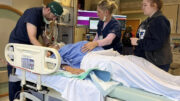PEDERNALES, Ecuador (AP) — The strongest earthquake to hit Ecuador in decades flattened buildings and buckled highways along its Pacific coast, sending the Andean nation into a state of emergency. As rescue workers rushed in, officials said Sunday at least 77 people were killed, over 588 injured and the damage stretched for hundreds of miles to the capital and other major cities.
The magnitude-7.8 quake, the strongest to hit Ecuador since 1979, was centered on Ecuador’s sparsely populated fishing ports and tourist beaches, 105 miles northwest of Quito, the capital.
Vice President Jorge Glas said there were deaths in the cities of Manta, Portoviejo and Guayaquil — all several hundred miles from the center of the quake struck shortly after nightfall.
In Pedernales, a town of 40,000 near the quake’s epicenter, dozens of scared residents slept in the streets while men equipped with little more than car headlights tried to rescue survivors who could be heard trapped under rubble.
“We’re trying to do the most we can, but there’s almost nothing we can do,” said Gabriel Alcivar, mayor of Pedernales.
Alcivar pleaded for authorities to send earth-moving machines and emergency rescue workers as dozens of buildings in the town were flattened, trapping residents among the rubble. He said looting had broken out amid the chaos but authorities were too busy trying to save lives to re-establish order.
“This wasn’t just a house that collapsed, it was an entire town,” he said.
President Rafael Correa signed a decree declaring a national emergency and rushed home from a visit to Rome, urging Ecuadoreans to stay strong while authorities handle the disaster.
Glaz said 10,000 armed forces had been deployed to help. In addition, 4,600 national police were sent to the towns of Manabi, Esmeraldas and Guayas y Santa Elena.
Officials said shelters had been set up and emergency portable hospitals were being deployed.
On social media, photos circulated of homes reduced to rubble, a shopping center’s roof torn apart, supermarket shelves shaking violently and a collapsed highway overpass that crushed a car. In Manta, the airport was closed after the control tower collapsed, injuring an air traffic control worker and a security guard.
Alberto Reynas, 58, was fishing off the coast of Pedernales when giant waves violently rocked his boat.
“It felt the same on sea as it did on land,” he said.
But he was shaken again when he returned to land to find the facade of his two-story home had fallen off into the streets. He has been unable to communicate with members of his family and spent the night sleeping outdoors with neighbors, keeping a close watch against thieves.
“It’s pure sadness. Everything is destroyed,” he said.
In the capital Quito, terrified people fled into the streets as the quake shook their buildings. It knocked out electricity in several neighborhoods and six homes collapsed but after a few hours, power was being restored, Quito’s Mayor Mauricio Rodas said.
“I’m in a state of panic,” said Zoila Villena, one of many Quito residents who congregated in the streets. “My building moved a lot and things fell to the floor. Lots of neighbors were screaming and kids crying.”
Among those killed was the driver of a car crushed by an overpass that buckled in Guayaquil, the country’s most populous city. The city’s international airport was also briefly closed. Hydroelectric dams and oil pipelines in the OPEC-member nation were shut down as a precautionary measure but so there were no reports of damage to them.
Towns near the epicenter were evacuated as a precautionary measure in case of hazardous tsunami waves but several hours later authorities said was safe for coastal residents to return to their homes.
Sports events and concerts were cancelled until further notice nationwide.
“It’s very important that Ecuadoreans remain calm during this emergency,” Glas said from Ecuador’s national crisis room.
The U.S. Geological Survey originally put the quake at a magnitude of 7.4 then raised it to 7.8. It had a depth of 12 miles. Dozens of aftershocks followed, one as strong as magnitude-5.5, and authorities urged residents to brace for even stronger ones in the coming hours and days.
David Rothery, a professor of geosciences at The Open University northeast of London said the quake was about six times as strong as the most powerful of two deadly earthquakes across the Pacific, in the southernmost of Japan’s four main islands. A magnitude-6.5 earthquake struck Thursday near Kumamoto, followed by a magnitude-7.0 earthquake just 28 hours later. The quakes have killed 41 people and injured about 1,500, flattened houses and triggered major landslides.
On Sunday, thousands of rescue workers searched a debris-strewn village in southern Japan for about a half-dozen missing people as U.S. military aircraft rushed to join the relief mission.






































